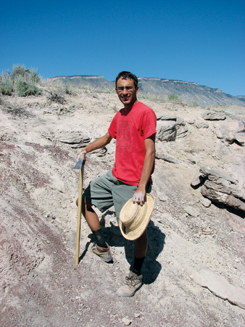Beyond the Quads
Dinosaur Discoverer
Dinosaurs debut.
The largest known carnivorous dinosaur to walk the earth, T. rex, the tyrannous lizard king, was deposed on December 12, 2007. On that day, Steve Brusatte, SB’06, and his former adviser at Chicago, Professor of Organismal Biology and Anatomy Paul Sereno, announced they had identified a bigger dinosaur in the southern hemisphere. Their article, “A new species of Carcharodontosaurus (Dinosauria: Theropoda) from the Cenomanian of Niger and a revision of the genus,” published in Journal of Vertebrate Paleontology, introduced the world to Carcharodontosaurus iguidensis, a meat-eater the size of a double-decker bus, with teeth as large as bananas. And it was not alone. A subsequent article, “Basal abelisaurid and carcharodontosaurid theropods from the Elrhaz Formation of Niger,” published February 2008 in Acta Palaeontologica Polonica, reported that the remains of two other “mega carnivores” had been found nearby in 2000: Kryptops palaios, or “old hidden face”—so named because of a horny covering over its face—and Eocarcharia dinops, or “fierce-eyed dawn shark,” which has razor-sharp teeth and a bony brow. It is incredibly rare to find remains of three different species of predators in such close proximity.
A native of Ottawa Township, Illinois, Brusatte may not have traveled far to study at the University of Chicago, but since then paleontology has taken him all over the world. Now at the University of Bristol on a Marshall Scholarship, the MSc candidate in paleobiology admits that a childhood interest in dinosaurs led him into the field—but it was not his own. When he was in high school, his youngest brother “was really going through a dinosaur phase for quite a while. I think everyone in the family thought he’d be the paleontologist,” Brusatte says. “Having him around with all of his dinosaur books, all of his dinosaur toys, and this brain just full of dinosaur facts was a huge influence on me. I saw paleontology as kind of like detective work in the deep past.” He began participating in nearby digs and publishing articles in amateur fossil-collector magazines. This early foray into journalism led to the publication of his first book, Stately Fossils, in 2002.
The Brusatte brothers also launched a Web site to share their passion for paleontology. Paul Sereno was among those Steve interviewed for the site. Brusatte says that his interviews with leading paleontologists “helped tremendously with just getting to know people in the field…. All of my various advisers that I’ve had—Paul, and Mike Benton in Bristol and also other people that I worked with—all of them I think I talked to when I was in high school.”
In the summer of 2004, Brusatte began work on his first project, with funding from a Howard Hughes Medical Institute grant: examining fossilized remains discovered in the Republic of Niger in 1997 and 2000—the lag time between discovery and examination is common in large laboratories. Brusatte explains, “Paul suspected they were new. He could see just by looking at them very quickly. There were differences, but whether or not they were important enough to establish a new species was an open question.” It was up to Brusatte to determine the answer. A second grant allowed him to continue his research the following summer. “Working on them and publishing about them was completely sponsored by these University fellowships. All of this is a great credit to the U of C and how they support undergrad research.” After the story of the discoveries finally broke in December 2007, Brusatte’s time was also consumed by press interviews that took him away from his research. Still, he embraced the opportunity to educate the public about paleontology. “More than anything, the Carcharodontosaurus iguidensis story and the two other dinosaurs were an incredible opportunity to reach out and show normal folks what we’re doing,” he says. “Most scientists never get that chance.”
A dinosaur with teeth as big as bananas may be media-ready; one named Carcharodontosaurus iguidensis, which refers to the creature’s genus and the region in which it was discovered, is a tougher sell. Brusatte admits that its neighbors, Kryptops palaios, and Eocarcharia dinops, might have an easier time getting traction with the all-important playground demographic. The publication of his second book, in September 2008, may also help. Dinosaurs, which Brusatte describes as “a big, highly visual coffee-table book that you see out front at Borders,” uses CGI images to tell the evolutionary story of dinosaurs. The book fits in with Brusatte’s goal to not just write scientific papers, but to translate paleontology into language and a package that regular people understand.
A White Sox fan, Brusatte laughs when asked whether he thinks there is any chance that his dinosaur discoveries might get him invited to throw out the first pitch at U.S. Cellular Field. “That would be something. I’d probably have to name a dinosaur after Jerry Reinsdorf, the owner of the Sox, or after Ozzie [Guillen, the team’s manager]. But that would be a bit like selling out.” —Amy Monaghan, AM’93
